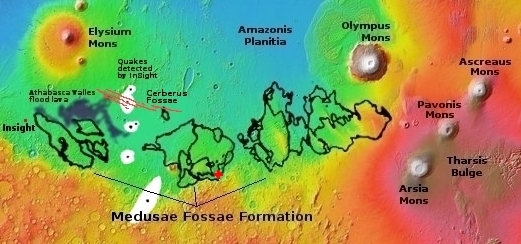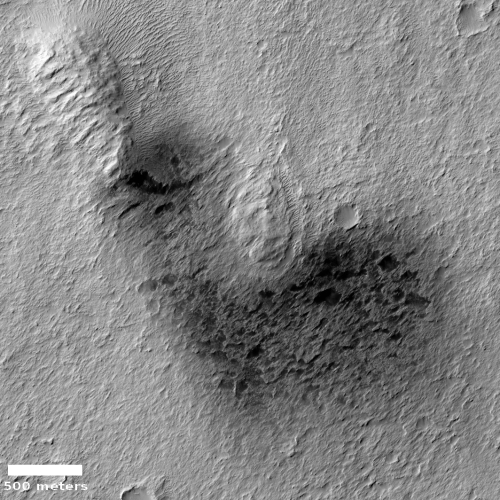Wind-blown dark material on Mars
Cool image time! The photo to the right, cropped and reduced to post here, was taken on May 13, 2021 by the high resolution camera on Mars Reconnaissance Orbiter (MRO). It shows a cluster of small depressions from which has blown dark material across the ground to the south. The full image also shows two craters north and south of this cluster that have similar dark material blown from their interiors.
When I first looked at this image, I wondered if the dark material and these depressions signaled a recently active volcanic vent where magma had spewed upward to stain the nearby ground. See for example this recent post about what some scientists believe might the most recent volcanic event so far found on Mars. I emailed several scientists for their thoughts, all of whom said this appears to not be active volcanism but merely windblown dark material.
Kim Seelos, science operations lead for MRO’s visible-near infrared spectrometer, put it simply. “My own reading of this image is that the dark areas here are likely akin to wind streaks.” Instead of the dark material being thrown from the depressions by a volcanic event, it was swept to the south by the prevailing winds.
How that dark material got into the depressions, and why it was so comparably darker than the surrounding terrain, remains unclear. David Horvath of the Planetary Science Institute in Arizona speculated that the low hills just north of the dark patch might be a factor.
The dark patch could be the result of a build-up of sand against those hills when the wind was blowing a different direction that is now being redistributed.
In other words, the dark dust could have piled up against those low hills when the primary wind direction was from the south, and is now being dispersed back to the south by today’s prevailing winds that now come from the north.

The overview map to the right marks the location of this photo with a red cross. It sits at the southern edge of the Medusae Fossae Formation, the largest volcanic ash deposit on Mars. Thus, while there does not appear to be a lot of dark ash in the full image, the dark splotches might be marking depressions where this ash was trapped when the volcanic ash of the Medusae formation was first being deposited. With time, most of that initial ash on the surface has blown away, leaving this terrain generally barren of it. Now the trapped ash in the depressions is being pulled out by the prevailing southerly winds, creating these dark splotches.
All speculation. There isn’t yet enough data to form a reliable hypothesis that explains what we see here. All we can do is speculate.
On Christmas Eve 1968 three Americans became the first humans to visit another world. What they did to celebrate was unexpected and profound, and will be remembered throughout all human history. Genesis: the Story of Apollo 8, Robert Zimmerman's classic history of humanity's first journey to another world, tells that story, and it is now available as both an ebook and an audiobook, both with a foreword by Valerie Anders and a new introduction by Robert Zimmerman.
The print edition can be purchased at Amazon or from any other book seller. If you want an autographed copy the price is $60 for the hardback and $45 for the paperback, plus $8 shipping for each. Go here for purchasing details. The ebook is available everywhere for $5.99 (before discount) at amazon, or direct from my ebook publisher, ebookit. If you buy it from ebookit you don't support the big tech companies and the author gets a bigger cut much sooner.
The audiobook is also available at all these vendors, and is also free with a 30-day trial membership to Audible.
"Not simply about one mission, [Genesis] is also the history of America's quest for the moon... Zimmerman has done a masterful job of tying disparate events together into a solid account of one of America's greatest human triumphs."--San Antonio Express-News
Cool image time! The photo to the right, cropped and reduced to post here, was taken on May 13, 2021 by the high resolution camera on Mars Reconnaissance Orbiter (MRO). It shows a cluster of small depressions from which has blown dark material across the ground to the south. The full image also shows two craters north and south of this cluster that have similar dark material blown from their interiors.
When I first looked at this image, I wondered if the dark material and these depressions signaled a recently active volcanic vent where magma had spewed upward to stain the nearby ground. See for example this recent post about what some scientists believe might the most recent volcanic event so far found on Mars. I emailed several scientists for their thoughts, all of whom said this appears to not be active volcanism but merely windblown dark material.
Kim Seelos, science operations lead for MRO’s visible-near infrared spectrometer, put it simply. “My own reading of this image is that the dark areas here are likely akin to wind streaks.” Instead of the dark material being thrown from the depressions by a volcanic event, it was swept to the south by the prevailing winds.
How that dark material got into the depressions, and why it was so comparably darker than the surrounding terrain, remains unclear. David Horvath of the Planetary Science Institute in Arizona speculated that the low hills just north of the dark patch might be a factor.
The dark patch could be the result of a build-up of sand against those hills when the wind was blowing a different direction that is now being redistributed.
In other words, the dark dust could have piled up against those low hills when the primary wind direction was from the south, and is now being dispersed back to the south by today’s prevailing winds that now come from the north.

The overview map to the right marks the location of this photo with a red cross. It sits at the southern edge of the Medusae Fossae Formation, the largest volcanic ash deposit on Mars. Thus, while there does not appear to be a lot of dark ash in the full image, the dark splotches might be marking depressions where this ash was trapped when the volcanic ash of the Medusae formation was first being deposited. With time, most of that initial ash on the surface has blown away, leaving this terrain generally barren of it. Now the trapped ash in the depressions is being pulled out by the prevailing southerly winds, creating these dark splotches.
All speculation. There isn’t yet enough data to form a reliable hypothesis that explains what we see here. All we can do is speculate.
On Christmas Eve 1968 three Americans became the first humans to visit another world. What they did to celebrate was unexpected and profound, and will be remembered throughout all human history. Genesis: the Story of Apollo 8, Robert Zimmerman's classic history of humanity's first journey to another world, tells that story, and it is now available as both an ebook and an audiobook, both with a foreword by Valerie Anders and a new introduction by Robert Zimmerman.
The print edition can be purchased at Amazon or from any other book seller. If you want an autographed copy the price is $60 for the hardback and $45 for the paperback, plus $8 shipping for each. Go here for purchasing details. The ebook is available everywhere for $5.99 (before discount) at amazon, or direct from my ebook publisher, ebookit. If you buy it from ebookit you don't support the big tech companies and the author gets a bigger cut much sooner.
The audiobook is also available at all these vendors, and is also free with a 30-day trial membership to Audible.
"Not simply about one mission, [Genesis] is also the history of America's quest for the moon... Zimmerman has done a masterful job of tying disparate events together into a solid account of one of America's greatest human triumphs."--San Antonio Express-News



Dark areas seem to fill a low spot in the land, ground water coming to the surface? The earth equivalent of a swap? at the base of glacier flow leaving dark minerals behind that did not blow far from the source?
The dark material doesn’t seem to fit the blowhole pattern we’ve seen before.
Maybe the darker dust has a better chance of being released from the original mineral matrix and is finer than what it leaves behind and can be picked up easier by the Martian winds. Maybe the small difference in solar heating due to it’s color possible coupled with a marked difference in thermal expansion allows it to work it’s way free of the originating rock.
I wonder how surface temperatures differ on Mars differ from Earth from direct solar heating because of a lower capacity for convection.
Just wild speculation of course.